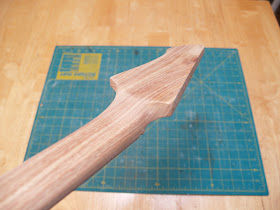 |
| I use leftover scrap wood to make knife handles. |
Thursday, March 31, 2011
Wednesday, March 23, 2011
Even the Portuguese Are Building My Guitars
Fabiano from Portugal sent me a link to his blog where he's detailing the construction of his own Highline Special. Check it out. Even if you don't understand Portuguese, you can copy and paste the link into google's translator, which will translate his blog into whatever language you prefer. He did a great job of sawing out the body's shape with just a jig saw!
Popping the Flame
I'm in the process of building another new Highline guitar design. You can follow the progress on my tumbler blog. At any rate, I wanted to share a photo I just took of the body after applying a wash of oil based stain. What looked like plain white Maple really came to life. As I walk around the body, the flame Maple's figure shifts. It's an optical illusion called chatoyancy and it creates a 3D like surface. Very cool.
Tuesday, March 22, 2011
The Highline Single Cut Is For Sale
I finally finished and posted my latest guitar build, the Highline Single Cut. Check it out at www.highlineguitars.com.
Honduran Mahogany. Panama Rosewood. Flamed Maple. TonePros. Only the best!
Honduran Mahogany. Panama Rosewood. Flamed Maple. TonePros. Only the best!
Sunday, March 20, 2011
Bid On A Tomahawk Electric Guitar
Now is your chance to own one of my Tomahawk custom electrics. This one is a neck through design made from the best wood available. I've got it on eBay with a a starting bid of $199.99. Click here to see this awesome guitar.
Thursday, March 17, 2011
My Latest Electric Guitar Neck
Along with several other electric guitar builds that I have in progress, I'm starting a new one, which will be called the Highline Neolux. I'm almost finished with making the neck and I thought I share some photos of the work up to this point:
 |
| The fretboard is Morado and the marker dots are Maple. |
 |
| I carved the volute as far forward as possible to keep it from interfering with the fretting hand. |
 |
| The neck itself is made from Canarywood and will be a bolt-on design with a minimal heel. |
 |
| Dig the truss rod adjustment access hole. |
 |
| I love the color and grain of Canarywood, not to mention its amazing tonal properties. |
Tuesday, March 15, 2011
The Key To Natural Sustain
When it comes to sustain in a guitar, there's certainly no shortage of opinions floating around the web. Some people claim it's the wood you select while others swear by a particular pickup or the way the neck is attached to the body as the main driving force behind good sustain. However, I've seen neck through guitars made from the best wood available and equipped with highly respected pickups that still seem to fall short in terms of sustain. Why? The answer lies where sustain actually begins: the strings.
The art of achieving good sustain begins with how well the strings are anchored at both ends of the scale. You could follow all the best rules of thumb in terms of wood, neck attachment and pickup selection, but if you ignore how well the strings are anchored at the nut and bridge, you're bound to be disappointed.
In an ideal situation, only the very bottom of each string should contact a knife-like edge where it leaves the nut and bridge. At the nut, no part of the slot should be in contact with the string except on the knife-like edge at the face. Same with the bridge. The string should only touch a knife-like edge as it leaves the saddle. No other part of the saddle's slot should be in contact with the string. This is how you achieve optimal bell-like sustain.
In the real world, however, this approach doesn't last very long since the strings act like mini grinders when played against these sharp edges. As a result, optimal sustain begins to fade as a guitar is played over time. How fast this happens depends on playing style, string gauge and tunings.
To achieve a good balance between optimal sustain and how long it will last requires slightly rounding off the knife-like edge. Unfortunately, the degree to which you round off the edges takes some practice and experience to master. However, if you have a guitar that lacks sustain, check the slots at the nut and bridge to make sure the strings aren't contacting too much of their respective slots. You should be able to press the strings down into the slot behind the face of the nut and bridge saddles. They should also move slightly from side to side behind the face of the nut and saddles. If there is no movement in any direction, it's likely the strings are in contact with the length of the slot and that, my friends, is what kills sustain.
Wednesday, March 9, 2011
Friday, March 4, 2011
On The Drawing Board
As I write this post, I am working on two new additions to the Super Easy Series of electric guitar plans. The first design is based on a CAD file sent to me by Brian in Wisconsin. You might remember his guitar from an earlier post here. The second design is a based on my Incubus design, which I've modified to use a bolt-on replacement neck and renamed the Venturi. Both will be available in the next couple of weeks. In the meantime, here are a couple of screenshots to salivate over:









